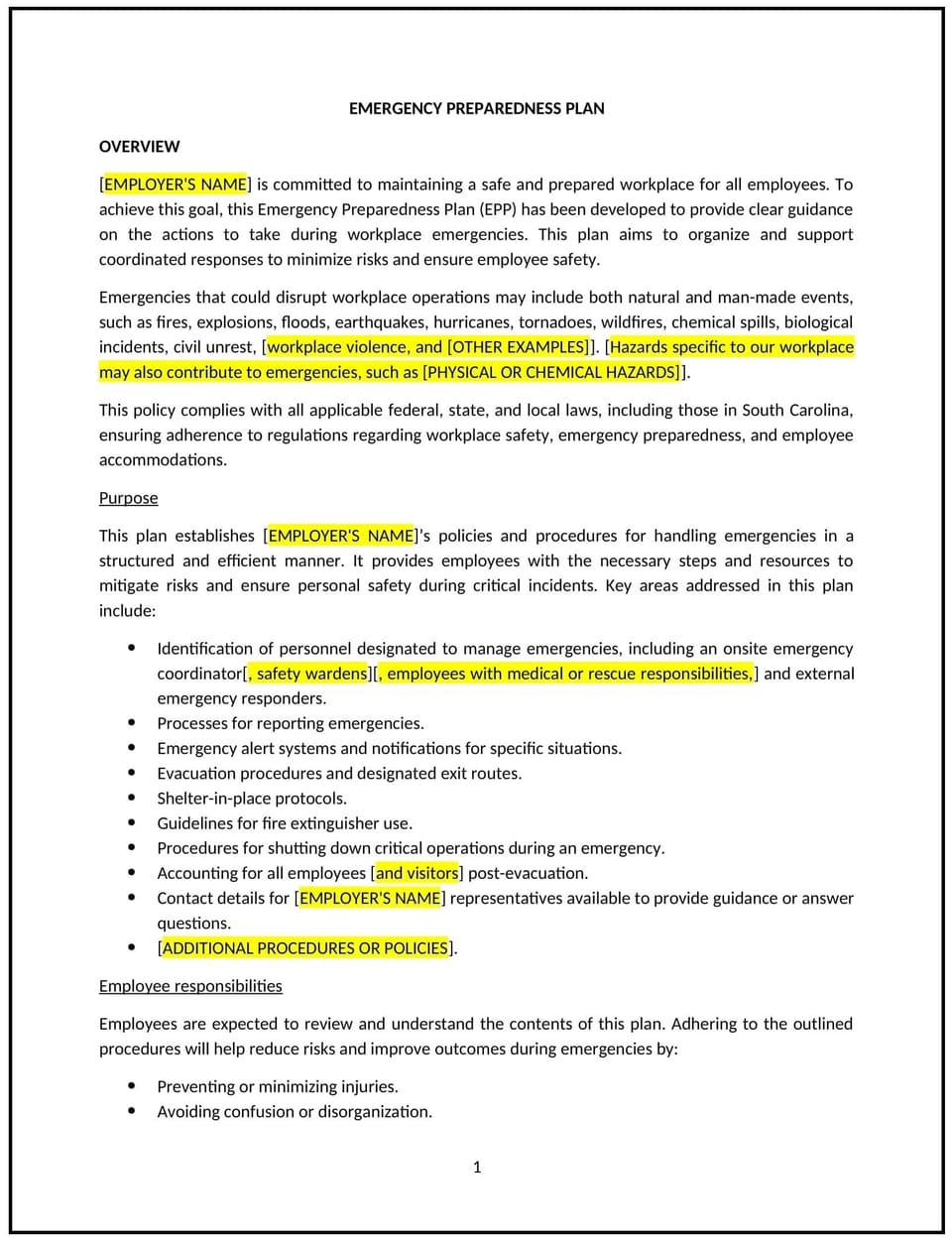Emergency preparedness plan (South Carolina): Free template

Emergency preparedness plan (South Carolina)
This emergency preparedness plan is designed to help South Carolina businesses create a framework for responding to emergencies, such as natural disasters, fires, or workplace incidents. It outlines procedures for evacuation, communication, and recovery to ensure employee safety and business continuity.
By adopting this plan, businesses can minimize risks, protect employees, and align with general best practices for emergency management.
How to use this emergency preparedness plan (South Carolina)
- Identify potential emergencies: Assess risks specific to the business, such as hurricanes, floods, or workplace accidents.
- Establish evacuation procedures: Provide clear instructions for evacuating the workplace safely and efficiently.
- Create communication protocols: Outline how employees will be notified of emergencies and updates.
- Designate roles: Assign responsibilities to employees, such as evacuation coordinators or first aid responders.
- Train employees: Educate staff on emergency procedures and their roles in executing the plan.
- Review and update: Assess the plan annually to ensure it aligns with evolving business needs and emergency response standards.
Benefits of using this emergency preparedness plan (South Carolina)
This plan offers several advantages for South Carolina businesses:
- Protects employees: Ensures employee safety by providing clear procedures for responding to emergencies.
- Minimizes risks: Reduces the potential for injuries, property damage, and business disruptions during emergencies.
- Aligns with best practices: Provides a structured approach to managing emergency situations.
- Builds trust: Demonstrates a commitment to employee safety and well-being.
- Supports business continuity: Helps businesses recover quickly and resume operations after an emergency.
Tips for using this emergency preparedness plan (South Carolina)
- Communicate the plan: Share the plan with employees and include it in the employee handbook.
- Provide training: Educate staff on emergency procedures and their roles in executing the plan.
- Conduct drills: Regularly practice emergency scenarios, such as fire drills or evacuation exercises.
- Monitor adherence: Regularly review emergency preparedness practices to ensure compliance with the plan.
- Update regularly: Assess the plan annually to ensure it aligns with evolving business needs and emergency response standards.
Q: How does this plan benefit businesses?
A: This plan protects employees, minimizes risks, and supports business continuity by providing clear procedures for responding to emergencies.
Q: What types of emergencies should businesses prepare for?
A: Businesses should prepare for natural disasters, fires, workplace accidents, and other potential emergencies specific to their location and operations.
Q: How can businesses ensure employees know their roles during an emergency?
A: Businesses should provide training, conduct drills, and assign specific roles, such as evacuation coordinators or first aid responders.
Q: How often should businesses conduct emergency drills?
A: Businesses should conduct drills at least annually or as needed to ensure employees are familiar with emergency procedures.
Q: How often should businesses review this plan?
A: Businesses should review the plan annually or as needed to ensure it aligns with evolving business needs and emergency response standards.
This article contains general legal information and does not contain legal advice. Cobrief is not a law firm or a substitute for an attorney or law firm. The law is complex and changes often. For legal advice, please ask a lawyer.


